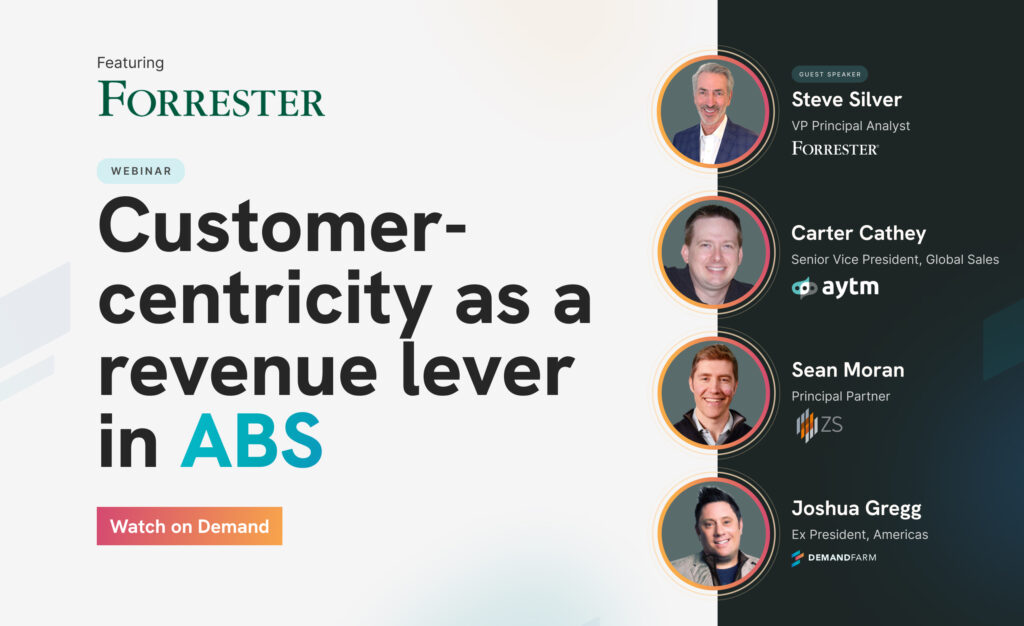Webinar: Step into the future of account management: Meet DemandFarm’s KAM AI

See how DemandFarm is redefining account planning in the era of AI, and finally making it possible for key account management teams to focus on selling. Catch seasoned KAM practitioners Jeremy King – Lead, Strategic Growth @ TrendyMinds and Harsh Sanklecha – AVP, Customer Success @ DemanadFarm share their unfiltered take on what’s game-changing, what’s just noise and what’s on the horizon for AI-driven account planning. Agenda: AI’s role in the evolution of account planning tools Top three AI trends that’ll shape account planning in 2025 and beyond Demo of DemandFarm’s KAM AI Watch the webinar on-demand:
Webinar: Customer-centricity as a revenue lever in ABS (Account-Based Selling)

The truism “creating value for your customers will eventually create revenue for your company” perhaps rings loudest in the targeted, relationship-heavy, high-value space of account-based selling. In Key Account Management (KAM), as we aim to move from being a vendor for our key accounts to a strategic partner who can co-create value, the single most dominant value that can drive this transformation is – customer-centricity. Unrelenting, obsessive, customer-centricity. In this webinar, Forrester analyst Steve Silver, Carter Cathey – SVP, Global Sales at Aytm, Sean Moran – Partner at ZS, and Joshua Gregg – Ex-President at DemandFarm discuss – Why you should make sales and customer success teams the gatekeepers of customer-centricity – Why revenue growth from your key customers requires a healthy amount of obsession in ABS – Leveraging technology for collaboration, co-creation, and personalization to deliver customer experience and drive sales performance – Aligning compensation models with a customer-centric culture Watch the webinar on-demand:
Breaking boundaries: ABM in Digital Era

The B2B landscape is undergoing a dynamic transformation, propelled by the forces of digitization, technological breakthroughs, and evolving workstyles. This multifaceted shift is reshaping the business landscape, fostering unprecedented growth and diversification. Account-based marketing or ABM is one such strategy that is aligned with account-based sales to target high-value accounts with personalized and targeted campaigns. The thought behind account-based marketing is to shift focus from volume-based lead generation programs to high-value and key accounts that are treated as individual markets. The guiding principles of ABM are the development of relationship strategies, account-specific messaging, and complete alignment between marketing and sales. ABM’s targeted activities go beyond the traditional practices of generic marketing and result in relationship acceleration where your team focuses on engaging and delighting high-value accounts. Groundbreaking technology such as Artificial Intelligence (AI) and Data Analytics are proving to be vital tools to implement ABM even as multichannel and omnichannel strategies are providing a more seamless customer experience. Importance of personalized and targeted marketing strategies The cornerstone of ABM is a customized approach that uses personalized and targeted marketing strategies to create a seamless marketing experience. Data is collected from different sources and analyzed to identify patterns to effectively target best-fit, high-value accounts. These data insights also help marketers to clearly understand the specific requirements of their target accounts and nurture relationships with better engagement. Through a personalized and targeted approach, ABM aligns your solutions to the account’s business needs and creates competitive positioning. Personalized marketing strategies have the potential to shift a targeted account from disinterest to engagement and awareness of your solutions. Targeted campaigns can also help you differentiate your offerings and position your company as the preferred provider of solutions for your high-value accounts. “In the current digital landscape, we are overwhelmed with information and advertising. Account-based marketing narrows it down to a level at which we get customized messages that specifically address our needs as professionals, the roles that we play, and the personas we have.” – Tejas Arur, Business Communication & Customer Engagement Strategist, Axtria Inc (Snippets from episode #10 of the Shift podcast) Tune in to the episode 10 of the Shift podcast, Dr. Karthik Nagendra, CMO at Demand Farm, interviews Tejas Arur, Business Communication & Customer Engagement Strategist at Axtria Inc., about the key principles and strategies behind account-based marketing in a digital age. Personalized and targeted marketing strategies also help contextualize your message to the state of the account and this proves to be far more effective than the ‘spray and pray’ approach. Role of Data Analytics and AI in Account-based Marketing AI and data analytics are transforming ABM by boosting personalization and creating meaningful communication. AI-enabled systems that align with your account’s needs also provide transparency which is crucial for the successful implementation of your strategies. Let’s look at how AI and data analytics are optimizing account-based marketing: 1. Account Profiling Profiling and defining customers is the starting point of any ABM program. The power of AI helps you deep dive into the internet and multiple databases to extract information for accurate customer profiling. This helps in the efficient allocation of your key resources to nurture key accounts and build lasting and fruitful relationships. 2. Creating Personalized Content Understanding your accounts and their specific needs and pain points can help you customize your offerings and provide bespoke solutions. With clear account profiles, ABM can customize content that appeals to your high-value accounts. AI can also help you segment data mined from CRM and marketing automation platforms to create hyper-individualized experiences. 3. Automating repetitive tasks ABM includes certain tasks like data management, campaign monitoring, and customer outreach that are significant but repetitive and tedious. You can leverage AI tools to automate these repetitive tasks and create more bandwidth for your team to focus on more strategic tasks to improve the overall campaign performance. Additionally, data management consulting can help ensure that your data processes are optimized, allowing for better decision-making and more effective use of AI tools in your ABM strategy. 4. Data Analytics & Reporting Data is the new currency and everywhere we go, we create data points that can be used by ABM to create bespoke experiences that suit the account’s needs specifically. AI-enabled tools help you demolish data silos by merging data from disparate sources. “Data analytics help us analyze behavior as well as segment and micro-segment and personalize content. Engagement analytics help us perform AB testing to know what kind of messaging to have, the value proposition, and product and services that we need to position,” – Tejas Arur, Business Communication & Customer Engagement Strategist, Axtria Inc (Snippets from episode #10 of the Shift podcast) AI also adds a new dimension to ABM by elevating simple reporting and descriptive analytics to predictive analytics. This helps you to tweak your recommendations in real-time and ensure your audience is not hassled by irrelevant offers. Synchronization between Account-based Marketing and Account-based Selling A comprehensive approach to ABM is built on the basis of complete synergy between marketing and sales. To ensure an engaging and personalized experience for your key accounts, you have to ensure that marketing and sales are on the same page. ABM can be successfully implemented only when roles and responsibilities are clearly assigned to the sales and marketing teams. They must work together on allocating resources for each account and ensuring that there’s a smooth transition between marketing and sales activities. The success of your account-based selling strategy largely depends on recognizing marketing as a part of the revenue team. Marketing can create customized marketing plans to create targeted campaigns for your high-value accounts. Both marketing and sales must work together at every step including reviewing the account plan and building successful campaigns. “Sales teams and marketing assets are means to create an experience for the customer. Marketing and sales are not opposites; sales bring in outcomes that lead to instant gratification. Marketing takes longer, it’s more empirical and the messaging creates a brand, a personality, and
Selecting Account-Based Selling Tools: The Essential Features

Account-Based Selling / Account-Based Sales (ABS) Tools Account-Based selling is no easy feat. It’s a complex, time-consuming process that can take your team months to perfect. But once you’ve cracked the code, it can be a compelling way to grow your business. Thankfully, advances in sales technology are making it easier than ever to implement an account-based selling strategy. Today, account-based sales tools empower sales leaders to understand the nuances of customer interactions with the proper context of their accounts. And the end results are no less than significant boosts in the CLV of each account. Account-based sales tools are software or technology solutions that support the execution of an account-based sales strategy. These tools help sales teams identify, target, and engage with high-value accounts by providing insights and intelligence about the accounts and their key decision-makers. But all this is only possible if account managers can overcome the involved limitations of traditional CRMs such as not being equipped enough to execute account planning to its full potential. This is primarily because traditional account planning execution happens offline with an increased reliance on PPTs and spreadsheets. This often leads to the absence of a single source of truth for data and reports along with a missing systematic link between Account-based Management and Account-based Selling. Thus, this calls for a system that empowers account managers to paint a comprehensive account picture and collaborate with every account stakeholder. Fortunately, new sales tools are emerging that help account managers overcome these limitations. These account-based sales tools provide a centralized platform for managing customer interactions and account data. They also offer features specifically designed to support an account-based selling strategy. 8 crucial must-have capabilities in account-based sales / account-based selling tools: Account Intelligence : The ability to surface insights about individuals and companies that can be used to identify new opportunities and create a strategy for targeting these accounts. Relationship Mapping : The ability to see how different individuals within an account are connected and track all interactions between team members. Whitespace Identification : The ability to find and target new prospects in accounts with the most growth potential. Account Planning : The ability to map out essential information about prospects such as the decision-makers, competitive position, and the core strategic components to win these accounts, among others. Opportunity Management : The ability to track all interactions with an account and all related opportunities and identify which deals are most likely to close starting from the first to the last stage. Pipeline Management : The ability to manage all deals in an account and their associated stages and values. Forecasting : The ability to predict future sales outcomes by understanding which deals are most likely to close and estimating the value of those closed deals. Collaboration : Identifying and updating contact and account data by unlocking a holistic picture of every key account. Creating coaching content alongside, such as process playbooks is also crucial. Once you have the right account-based sales tools in place, it’s essential to ensure everyone on your team is using them effectively. That means appropriately training sales reps on using the tools and giving them the tools they need to be successful. The best account-based sales tools make it easy for sales reps to identify and target key accounts, build relationships with key stakeholders, and track all interactions with those stakeholders. This information can then be used to create targeted content and sales pitches relevant to each account. How Account-Based Selling Tools Help Maximizing Account Revenue Account-based selling tools are vital to maximizing the revenue from every key account by bridging the gaps between intent signals and growth opportunities. They do this via Connected Apps Ecosystem : Account-based selling platforms integrate with existing data and tech stacks to drastically improve forecasting accuracy. Predictive analytics can help identify which deals are most likely to close by analyzing past customer interactions and current account data. Sales Enablement : Account-based selling tools provide the sales team with the right content at the right time to help them close more deals. This content is tailored to the specific needs of each account and is delivered through channels that the customer is most likely to use. Account-based Selling Strategy : The right account-based selling tools can help sales leaders to develop a detailed account-based selling strategy and an account-based selling framework. This strategy will identify the best path that best integrates with the existing complexity of tech stacks. We are proud to share that DemandFarm has been recognized as one such leading account-based sales tool from a globally leading Independent Research Firm in the space of Account-based Sales Tools. Forrester Recognizes DemandFarm as a Mature Vendor in Account-Based Sales Technologies The report gives insight into what companies that use Account-Based Selling tools can expect. DemandFarm is mentioned as one of the few vendors that can provide account insights, opportunity tracking, and relationship mapping. For more information on how to maximize account revenue, please contact us. We would be happy to discuss our services and the many benefits of using an account-based sales tool!
Account-Based Selling – The Beginner’s Guide to B2B Account-Based Sales

Account-Based Sales Is account-based sales or account-based selling a part of your go-to-market strategy for B2B sales? Why? Why not? An account-based selling approach to growth could stem from the following reasons. Your offering caters to a specific segment of a larger market, e.g., B2B outsourcing companies in the IT services space. Your product-led growth is tapering off because of competing products. The existing inbound marketing funnel is providing marginal growth. When you sell to enterprises and check one or more points off the list above, the lead-based approach becomes futile. Through our failures and triumphs of losing and closing deals, we have now learned that it makes more sense to customize our account-based selling approach and strategy to convert rather than going through the entire range in a sales funnel. The Pareto Principle indicates that, in a B2B sales set-up, about 80% of revenue comes from only 20% of customers. In such a scenario, becoming strategic about the accounts that bring in the most revenue and investing more time, revenue and manpower in engaging and growing them has become imperative. In the mid-2010s, account-based sales or hyper-segmented selling emerged from the concept of account-based strategy. Even though the idea is comparatively recent, it holds the potential to alter the reality of how organizations buy and sell. In fact, a report by Gartner, 2020 predicts that Account-Based Selling (ABS) will be the basis of sales for most technology vendors, and the volume of this market will exceed $5 billion per year. Enterprise B2B Sales demands a shift of focus from ‘quantity’ to ‘quality.’ What is Account-Based Selling? Account-based selling is a strategic ‘hyper-segmented’ sales process that has been developed to pursue a few but high-value accounts rather than several individual leads. It focuses on enterprise selling in the B2B sales context to target larger accounts with large deal sizes and non-linear buying journeys. In such purchase processes, an average of 11 stakeholders are involved in the decision-making and account-based selling or ABS through stakeholder mapping tries to incorporate all the key people in the transaction, taking into account their business interests and offering them a consultative, customized solution. Account-Based Selling takes a holistic view and relies on cross-organizational alignment. It involves coming together of the various departments such as Sales, Customer Success, Marketing, Finance, Product, Engineering, and the C-suite within an organization to align on the same goal and strategy. It requires the teams to work together to generate high-value engagements with the people in these accounts across a number of platforms with an approach that is tailored to that account’s need. It is no longer a numbers game, but a value game with account-based selling. KAM Glossary: Crucial Account Management Terms Explained Account-Based Selling KPIs While transitioning to the account-based methodology from a traditional B2B sales approach, updating and tracking relevant KPIs becomes crucial. Following are some you can start with: 1. Account Conversion Rate Conversions are the estimation of the success of your account-based selling strategy. Following are some parameters that you can compare conversion rates with for better comprehension of the impact ABS is having on your organization. CAC: Customer Acquisition Costs LTV: Customer Lifetime Value ACV: Average Contract Value and Length of the Average Deal 2. Engagement Account-based selling improves engagement with your accounts. Despite a long nurturing process, you can quantify development by tracking how keenly the right people at an account are engaging with you. Engagement could be anything from if they talk to your sales team, if they are using your products, if they are interacting with you on your socials to if they respond to your marketing efforts. You can also track success in engagements by channels and figure out what the people in a particular account positively respond to. 3. Data Quality Rich, scientific data is one of the most important investments you will make in your account-based strategy. Data quality is built through exhaustive research of your target accounts. You need to understand divisions within your target account and identify the key stakeholders within them. Your data should include their roles and contact information and a built-in mechanism to update this information as and when it changes. 4. Sales Cycle Length The B2B sales cycle length is the number of days it takes for a deal to close. It becomes important to measure this in an effort to optimize the process through focus on the needs of the account. In ABS, personalization is the key identifier in achieving that. 5. White Space White space analysis helps you identify the gap between the information you have about the account you are targeting and the information you need to close the deal. Efforts should be made to keep this space as narrow as possible to increase the overall account-based selling effectiveness. Reduced white space opportunity will help you tailor content and communication that is more accurate and relevant for your accounts. While tracking account-based selling metrics, the focus should be on quality and long-term insight driven customer relationship building and revenue would follow. Is Account-Based Selling for You? Now that you know what KPIs you will need to track, let’s dive into if ABS is for you. Transitioning to an account-based strategy requires significant time, manpower, and investments. You need to pit the following factors against the metrics that are discussed in the above section to evaluate what is best for your organization. The ABS strategy lets you allocate resources towards targeting larger B2B accounts and close fewer deals but expand your revenue and deal size. Jon Miller from Engagio talks about the WHO, the WHAT, and the WHERE of account-based sales development to evaluate if it’s worth dipping your feet into. The WHO of Account-Based Selling The WHO describes the accounts you need to go after and the people in those accounts. The more accurately you can understand your buyer, the better- as it may give you a clear understanding of who you are marketing and selling to. Buyer Personas